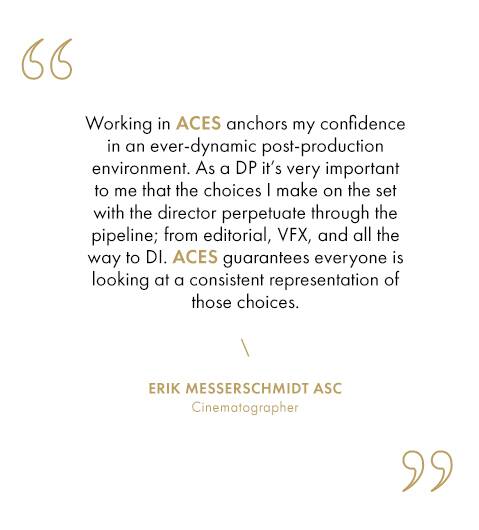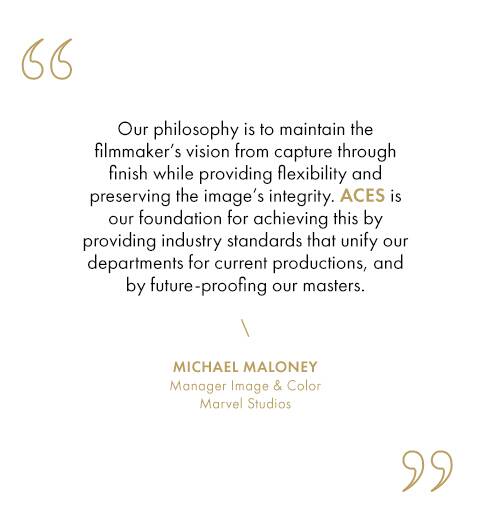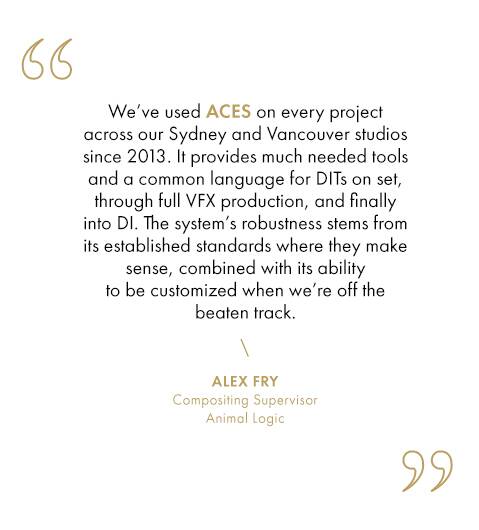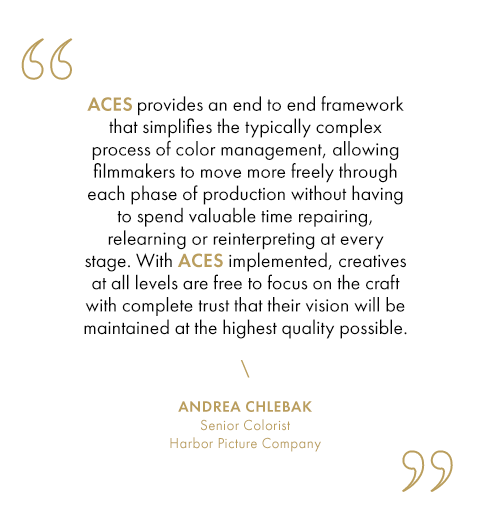
NEWS: check out ACEScentral.com the filmmakers portal to all things aces!
Follow us on: Twitter | Facebook | YouTube
What is ACES?
The Academy Color Encoding System (ACES) is the industry standard for managing color throughout the life cycle of a motion picture or television production. From image capture through editing, VFX, mastering, public presentation, archiving and future remastering, ACES ensures a consistent color experience that preserves the filmmaker’s creative vision. In addition to the creative benefits, ACES addresses and solves a number of significant production, post-production, delivery, and archiving problems that have arisen with the increasing variety of digital cameras and formats in use, as well as the surge in the number of productions that rely on worldwide collaboration using shared digital image files.
ACES is a free, open, device-independent color management and image interchange system that can be applied to almost any current or future workflow. It was developed by hundreds of the industry’s top scientists, engineers and end users, working together under the auspices of the Academy of Motion Picture Arts and Sciences.
ACES 1.0 was the first production-ready release of the system, the result of over 10 years of research, testing and field trials. It includes support for a wide variety of digital and film-based production workflows, visual effects, animation, final delivery and archiving. The most current release version, ACES 1.2, clarifies some specifications and addresses a few user-generated comments and requests and is being widely used around the globe. ACES 2.0, currently in development, will simplify and add support for additional workflows. It is being created using our open and transparent ACESNext Virtual Working Group development process and is expected to be available in 2021.
WHAT PRODUCTIONS HAVE USED ACES?
There have been many significant and successful uses of ACES in motion pictures, television, documentaries, commercials and even VR. For a partial list of motion picture and television productions, please visit ACESCentral.com

What problems does ACES 1.2 solve?
Today’s motion pictures and television shows are complex collaborative efforts, involving many separate companies using digital image capture, image creation and editorial workflows that are much more difficult to integrate than film-based workflows.
On a typical production there might be half a dozen different digital cameras as well as a film camera in use, all recording to different devices and media using different data formats. During post-production, especially on major motion pictures, multiple facilities may be engaged for editing, visual effects, mastering and other work. Digital image files arrive at these facilities in any of a dozen (or more!) formats and color encoding schemes, often without essential metadata. At the end of the process, studio deliverables could range from large-screen film prints to mobile device encodings.
All along the way, the integration challenges increase – and on the horizon there are undoubtedly emerging technologies and new all-digital distribution platforms that will add complexities of their own.
ACES 1.2 solves numerous integration challenges by enabling consistent, high-quality color management from production to distribution. It provides digital image encoding and other specifications that preserve the latitude and color range of the original imagery, allowing the highest-quality images possible from the cameras and processes used. Equally important, ACES 1.2 establishes a common standard so deliverables can be efficiently and predictably created and preserved. ACES 1.2 enables filmmakers to manage the look of a production today and into the future.
What are the benefits of ACES 1.2 for specific users?
Virtually everyone involved in production, post-production and archiving can enjoy ACES benefits.
For cinematographers, colorists and digital imaging technicians, ACES 1.2 preserves creative intent from on-set capture to presentation by:
- Eliminating uncertainty between on-set look management and downstream color correction through standardized viewing transforms and equipment calibration methods
- Preserving the full range of highlights, shadows and colors captured on set for use throughout post-production and mastering
- Simplifying the matching of images from different cameras
- Providing a means to repurpose source materials when creating alternate deliverables
For visual effects and other post-production facilities, ACES 1.2 streamlines digital workflows by:
- Simplifying the interchange of unfinished motion picture imagery
- Providing a standard color management architecture that can be shared by hardware and software vendors
- Eliminating uncertainty associated with undocumented or poorly documented file formats and color encodings
- Establishing standards for metadata
For producers and studios, ACES 1.2 reduces production costs and enables future-proofed archiving by:
- Providing a free, open source color and look management architecture that can be shared by vendors whose hardware and software products are used on set and in post-production
- Ensuring digital assets can be repurposed to take advantage of future high-dynamic-range, wide-color-gamut display devices
- Ensuring the archive contains the highest fidelity digital source master possible, representing the digital equivalent of the “finished negative”

ACES 1.2 Key Features
ACES 1.2 is a color management and image interchange system designed for production, mastering and long-term archiving of motion pictures. It is a complete, production-ready public release of the Academy Color Encoding System. Its key features include:0 is a color management and image interchange system designed for production, mastering and long-term archiving of motion pictures. It is the first complete, production-ready public release of the Academy Color Encoding System. Its key features include:
- Preservation of available exposure latitude and color range of digital motion picture cameras and film negative for use throughout the production pipeline
- Consistent and predictable display of images on a wide range of display devices
- Support for consistent on-set image preview and look management
- Portable color pipeline configuration, pre-grade and look management information
- Archive-ready digital image file format and metadata
ACES is an extensible system that enables innovation. It will grow with evolving filmmaking technologies, tools and techniques.

ACES 1.2 Product Information
The goal of the ACES 1.2 release is to encourage and accelerate adoption by enabling more consistent, user-friendly product implementations and by providing suitable support and educational materials to equipment manufacturers, service providers and end users.
There are currently many products that will allow you to use ACES 1.2 in your workflows. Companies that have pledged to incorporate ACES support into their products and allow the Academy to verify that their implementations meet the ACES spec are listed on the Product Partner Page. In addition, many other products can be used directly or through the use of OpenColorIO (OCIO) as a bridge into an ACES color managed workflow.
The ACES 1.2 release includes the following components:
New Features:
- Add ACES Metadata File specification document (S-2019-001), XML schema, and example files
- Add new version of Common LUT Format specification document (S-2014-006)
- Add new ACES Project Organization and Development Procedure document (P-2019-001)
- Add ACES Color Space Conversion transforms between:
- ACES and Canon Canon Log 2 Cinema Gamut
- ACES and Canon Canon Log 3 Cinema Gamut
- ACES and ARRI ALEXA LogC (EI800) WideGamut
- ACES and RED Log3G10 REDWideGamutRGB
- ACES and Sony S-Log3 S-Gamut3
- ACES and Sony S-Log3 S-Gamut3.Cine
- ACES and Panasonic Varicam V-Log V-Gamut
- Add HDR Output Transforms (RRT+ODT):
- P3D65 (1000 cd/m^2) ST.2084 (and inverse)
- P3D65 (2000 cd/m^2) ST.2084 (and inverse)
- P3D65 (4000 cd/m^2) ST.2084 (and inverse)
- Add vendor-supplied IDTs for Sony VENICE
Other:
- Update ACES System Versioning document (S-2014-002)
- Update TransformIDs of ACES reference implementation transforms
- Remove "Academy Color Encoding System (ACES) Clip-level Metadata File Format Definition and Usage" (TB-2014-009)
- Add reference images to accompany new ACEScsc transforms
Source code bundle:
https://github.com/ampas/aces-dev/releases/tag/v1.2
Source code repository:
https://github.com/ampas/aces-dev/tree/v1.2
Click here to view the latest ACES Documentation.


End User Support
The first place to seek support in using ACES is our ACES Community Forum, also accessible from our website ACESCentral.com under the community tab. There you’ll find a robust community of people ready to help you with almost any general or specific question you may have about ACES.
There are also a number of startup and do-it-yourself resources including the ACES Primer and Quick Start Guides which will provide you with a basic understanding of ACES and some tips for different roles in the production and postproduction chain.
The ever-growing Knowledge Base has helpful articles written by the ACES Team and users on various common questions and topics.
The ACES Video Channel has a lot of helpful videos, including tool set-up videos from some of the Product Partners and users.
We also encourage you to contact the Product Partners directly (camera manufacturers, color correctors, VFX software providers, display manufacturers, etc.) for the status of their ACES implementations and for ACES support on their specific products.
If you are a director, director of photography, digital imaging technician, VFX or post-production facility, editor, colorist, archivist, or other production or post-production professional, and have specific questions on how to use ACES on an upcoming project that you would prefer not to disclose publicly, please contact the Aces Team at acessuport@oscars.org. We will do our best to facilitate your efforts.

Developer and Product Partner Support
For developers and ACES Product Partners, support for the ACES 1.2 and ongoing development is available from a number of sources:
Product Documentation
There are a number of important documents that guide you through the process of implementing ACES 1.2. We urge you to review these documents carefully.
Technical Documents
Reference Implementation
ACESNext Development Efforts
All Product Partners and developers are encouraged to join the community-driven effort to build the next generation of ACES. By joining Virtual Working Groups, you can both contribute to the future of ACES and keep up to date on all developments so you’re ready to implement the newest features as soon as possible. Learn more about the ACESNext Working Groups
ACES Public Discussion Forum
Visit the public ACES Discussion Forum where developers and end-users may ask questions of the community and search for answers to issues that others might have faced.
Github Issue Reporting
Github hosts the public ACES source code repository where you may report specific issues found with Developer Release code and/or documentation. Use this mechanism for code or script issues, or suggested future enhancement.
E-mail Support for Product Partners
Existing and prospective potential Product Partners may e-mail questions or issues regarding the implementation of any of the ACES 1.2 components. E-mail: acessupport@oscars.org
Marketing Support
Product Partners, facilities or filmmakers may send emails to the ACES Team with suggestions for highlighting ACES in productions and products via case studies or other means. E-mail: acessupport@oscars.org
What is the ACES Logo Program?
The ACES Logo Program seeks to further the adoption of ACES throughout all segments of the industry. The Program initially focuses on production and post‐production equipment and tools (“Product Partners”) because without consistent, high‐quality ACES support in products, facilities and productions cannot benefit from ACES. Future enhancements to the Logo Program will cover facilities ("Service Partners") such as dailies providers, VFX studios, DI and mastering facilities. Eventually, the Program may include the ability for actual motion picture and television productions to earn a Logo (i.e. an ACES ‘bug’ at the end of a movie.)
The ACES Logo is a signal to end-users and filmmaking professionals that a Logo’d product or service meets the Logo Program qualification criteria and this should translate into a more satisfying ACES experience when part of a properly configured ACES color-managed workflow.
The 31 companies listed below are supporting ACES adoption, as Product Partners and by building ACES support into one or more of their products.
To become an ACES Product Partner, please review the application process and submit your application if your company meets Program requirements.
| Logo Product Partner | Product Group(s) |
|---|---|
| ARRI | Camera |
| Assimilate | Color Corrector |
| Autodesk | 3D Software/Color Corrector/Compositor |
| Avid Technology | Editorial Finishing |
| Canon | Camera/Display |
| Codex | On-set |
| Colorfront | Color Corrector |
| Color Trix | Color Corrector |
| Deluxe | On-set |
| Digital Vision | Color Corrector |
| DJI | Camera |
| Dolby Laboratories | Display |
| FilmLight | Color Corrector |
| FotoKem | On-set |
| The Foundry | Compositor |
| FireFly Cinema | Color Corrector |
| In2Core | On-Set Color Corrector |
| Grass Valley | Color Corrector |
| Laser Graphics | Film Scanner |
| Light Illusion | Color Tool |
| Marquise Technologies | Color Corrector |
| MTI Film | On-set |
| Panasonic | Camera |
| Pomfort | Inline Signal Processor |
| RED Digital Cinema | Camera |
| SGO | Color Corrector |
| Shotgun Software | Content Mgmt. System |
| Sony Electronics | Camera/Display |
| Technicolor | On-set |
| TVLogic (Vidente Co., Ltd.) | On-Set color corrector |
| Vision Research | Camera |

ACES is an industry-wide collaboration under the auspices of the Academy of Motion Picture Arts and Sciences. Hundreds of individuals and dozens of companies have contributed – and continue to contribute – to the science, technology, practices and real-world testing required to make ACES the industry-standard color management and image interchange system.
On behalf of the entire industry, the Academy and ACES Project Leadership wish to thank the following companies and organizations for their contributions to ACES development and testing on ACES 1.0:
|
ACES Project Committee Chair
Annie Chang
ACES Project Committee Vice-chairs
Joachim Zell • Rod Bogart
The Academy also wishes to acknowledge the many individual contributors that participated in the development of ACES 1.0, as well as these additional professionals participating in the ACESNext efforts:
Technical Advisory Council members
Virtual Working Group Contributors
Please note: nothing herein expresses or implies an endorsement of any company, production or individual by A.M.P.A.S.
What is ACES?
The Academy Color Encoding System (ACES) is the industry standard for managing color throughout the life cycle of a motion picture or television production. From image capture through editing, VFX, mastering, public presentation, archiving and future remastering, ACES ensures a consistent color experience that preserves the filmmaker’s creative vision. In addition to the creative benefits, ACES addresses and solves a number of significant production, post-production, delivery, and archiving problems that have arisen with the increasing variety of digital cameras and formats in use, as well as the surge in the number of productions that rely on worldwide collaboration using shared digital image files.
ACES is a free, open, device-independent color management and image interchange system that can be applied to almost any current or future workflow. It was developed by hundreds of the industry’s top scientists, engineers and end users, working together under the auspices of the Academy of Motion Picture Arts and Sciences.
ACES 1.0 was the first production-ready release of the system, the result of over 10 years of research, testing and field trials. It includes support for a wide variety of digital and film-based production workflows, visual effects, animation, final delivery and archiving. The most current release version, ACES 1.2, clarifies some specifications and addresses a few user-generated comments and requests and is being widely used around the globe. ACES 2.0, currently in development, will simplify and add support for additional workflows. It is being created using our open and transparent ACESNext Virtual Working Group development process and is expected to be available in 2021.
WHAT PRODUCTIONS HAVE USED ACES?
There have been many significant and successful uses of ACES in motion pictures, television, documentaries, commercials and even VR. For a partial list of motion picture and television productions, please visit ACESCentral.com

What problems does ACES 1.2 solve?
Today’s motion pictures and television shows are complex collaborative efforts, involving many separate companies using digital image capture, image creation and editorial workflows that are much more difficult to integrate than film-based workflows.
On a typical production there might be half a dozen different digital cameras as well as a film camera in use, all recording to different devices and media using different data formats. During post-production, especially on major motion pictures, multiple facilities may be engaged for editing, visual effects, mastering and other work. Digital image files arrive at these facilities in any of a dozen (or more!) formats and color encoding schemes, often without essential metadata. At the end of the process, studio deliverables could range from large-screen film prints to mobile device encodings.
All along the way, the integration challenges increase – and on the horizon there are undoubtedly emerging technologies and new all-digital distribution platforms that will add complexities of their own.
ACES 1.2 solves numerous integration challenges by enabling consistent, high-quality color management from production to distribution. It provides digital image encoding and other specifications that preserve the latitude and color range of the original imagery, allowing the highest-quality images possible from the cameras and processes used. Equally important, ACES 1.2 establishes a common standard so deliverables can be efficiently and predictably created and preserved. ACES 1.2 enables filmmakers to manage the look of a production today and into the future.
What are the benefits of ACES 1.2 for specific users?
Virtually everyone involved in production, post-production and archiving can enjoy ACES benefits.
For cinematographers, colorists and digital imaging technicians, ACES 1.2 preserves creative intent from on-set capture to presentation by:
- Eliminating uncertainty between on-set look management and downstream color correction through standardized viewing transforms and equipment calibration methods
- Preserving the full range of highlights, shadows and colors captured on set for use throughout post-production and mastering
- Simplifying the matching of images from different cameras
- Providing a means to repurpose source materials when creating alternate deliverables
For visual effects and other post-production facilities, ACES 1.2 streamlines digital workflows by:
- Simplifying the interchange of unfinished motion picture imagery
- Providing a standard color management architecture that can be shared by hardware and software vendors
- Eliminating uncertainty associated with undocumented or poorly documented file formats and color encodings
- Establishing standards for metadata
For producers and studios, ACES 1.2 reduces production costs and enables future-proofed archiving by:
- Providing a free, open source color and look management architecture that can be shared by vendors whose hardware and software products are used on set and in post-production
- Ensuring digital assets can be repurposed to take advantage of future high-dynamic-range, wide-color-gamut display devices
- Ensuring the archive contains the highest fidelity digital source master possible, representing the digital equivalent of the “finished negative”

ACES 1.2 Key Features
ACES 1.2 is a color management and image interchange system designed for production, mastering and long-term archiving of motion pictures. It is a complete, production-ready public release of the Academy Color Encoding System. Its key features include:0 is a color management and image interchange system designed for production, mastering and long-term archiving of motion pictures. It is the first complete, production-ready public release of the Academy Color Encoding System. Its key features include:
- Preservation of available exposure latitude and color range of digital motion picture cameras and film negative for use throughout the production pipeline
- Consistent and predictable display of images on a wide range of display devices
- Support for consistent on-set image preview and look management
- Portable color pipeline configuration, pre-grade and look management information
- Archive-ready digital image file format and metadata
ACES is an extensible system that enables innovation. It will grow with evolving filmmaking technologies, tools and techniques.

ACES 1.2 Product Information
The goal of the ACES 1.2 release is to encourage and accelerate adoption by enabling more consistent, user-friendly product implementations and by providing suitable support and educational materials to equipment manufacturers, service providers and end users.
There are currently many products that will allow you to use ACES 1.2 in your workflows. Companies that have pledged to incorporate ACES support into their products and allow the Academy to verify that their implementations meet the ACES spec are listed on the Product Partner Page. In addition, many other products can be used directly or through the use of OpenColorIO (OCIO) as a bridge into an ACES color managed workflow.
The ACES 1.2 release includes the following components:
New Features:
- Add ACES Metadata File specification document (S-2019-001), XML schema, and example files
- Add new version of Common LUT Format specification document (S-2014-006)
- Add new ACES Project Organization and Development Procedure document (P-2019-001)
- Add ACES Color Space Conversion transforms between:
- ACES and Canon Canon Log 2 Cinema Gamut
- ACES and Canon Canon Log 3 Cinema Gamut
- ACES and ARRI ALEXA LogC (EI800) WideGamut
- ACES and RED Log3G10 REDWideGamutRGB
- ACES and Sony S-Log3 S-Gamut3
- ACES and Sony S-Log3 S-Gamut3.Cine
- ACES and Panasonic Varicam V-Log V-Gamut
- Add HDR Output Transforms (RRT+ODT):
- P3D65 (1000 cd/m^2) ST.2084 (and inverse)
- P3D65 (2000 cd/m^2) ST.2084 (and inverse)
- P3D65 (4000 cd/m^2) ST.2084 (and inverse)
- Add vendor-supplied IDTs for Sony VENICE
Other:
- Update ACES System Versioning document (S-2014-002)
- Update TransformIDs of ACES reference implementation transforms
- Remove "Academy Color Encoding System (ACES) Clip-level Metadata File Format Definition and Usage" (TB-2014-009)
- Add reference images to accompany new ACEScsc transforms
Source code bundle:
https://github.com/ampas/aces-dev/releases/tag/v1.2
Source code repository:
https://github.com/ampas/aces-dev/tree/v1.2
Click here to view the latest ACES Documentation.


End User Support
The first place to seek support in using ACES is our ACES Community Forum, also accessible from our website ACESCentral.com under the community tab. There you’ll find a robust community of people ready to help you with almost any general or specific question you may have about ACES.
There are also a number of startup and do-it-yourself resources including the ACES Primer and Quick Start Guides which will provide you with a basic understanding of ACES and some tips for different roles in the production and postproduction chain.
The ever-growing Knowledge Base has helpful articles written by the ACES Team and users on various common questions and topics.
The ACES Video Channel has a lot of helpful videos, including tool set-up videos from some of the Product Partners and users.
We also encourage you to contact the Product Partners directly (camera manufacturers, color correctors, VFX software providers, display manufacturers, etc.) for the status of their ACES implementations and for ACES support on their specific products.
If you are a director, director of photography, digital imaging technician, VFX or post-production facility, editor, colorist, archivist, or other production or post-production professional, and have specific questions on how to use ACES on an upcoming project that you would prefer not to disclose publicly, please contact the Aces Team at acessuport@oscars.org. We will do our best to facilitate your efforts.

Developer and Product Partner Support
For developers and ACES Product Partners, support for the ACES 1.2 and ongoing development is available from a number of sources:
Product Documentation
There are a number of important documents that guide you through the process of implementing ACES 1.2. We urge you to review these documents carefully.
Technical Documents
Reference Implementation
ACESNext Development Efforts
All Product Partners and developers are encouraged to join the community-driven effort to build the next generation of ACES. By joining Virtual Working Groups, you can both contribute to the future of ACES and keep up to date on all developments so you’re ready to implement the newest features as soon as possible. Learn more about the ACESNext Working Groups
ACES Public Discussion Forum
Visit the public ACES Discussion Forum where developers and end-users may ask questions of the community and search for answers to issues that others might have faced.
Github Issue Reporting
Github hosts the public ACES source code repository where you may report specific issues found with Developer Release code and/or documentation. Use this mechanism for code or script issues, or suggested future enhancement.
E-mail Support for Product Partners
Existing and prospective potential Product Partners may e-mail questions or issues regarding the implementation of any of the ACES 1.2 components. E-mail: acessupport@oscars.org
Marketing Support
Product Partners, facilities or filmmakers may send emails to the ACES Team with suggestions for highlighting ACES in productions and products via case studies or other means. E-mail: acessupport@oscars.org
What is the ACES Logo Program?
The ACES Logo Program seeks to further the adoption of ACES throughout all segments of the industry. The Program initially focuses on production and post‐production equipment and tools (“Product Partners”) because without consistent, high‐quality ACES support in products, facilities and productions cannot benefit from ACES. Future enhancements to the Logo Program will cover facilities ("Service Partners") such as dailies providers, VFX studios, DI and mastering facilities. Eventually, the Program may include the ability for actual motion picture and television productions to earn a Logo (i.e. an ACES ‘bug’ at the end of a movie.)
The ACES Logo is a signal to end-users and filmmaking professionals that a Logo’d product or service meets the Logo Program qualification criteria and this should translate into a more satisfying ACES experience when part of a properly configured ACES color-managed workflow.
The 31 companies listed below are supporting ACES adoption, as Product Partners and by building ACES support into one or more of their products.
To become an ACES Product Partner, please review the application process and submit your application if your company meets Program requirements.
| Logo Product Partner | Product Group(s) |
|---|---|
| ARRI | Camera |
| Assimilate | Color Corrector |
| Autodesk | 3D Software/Color Corrector/Compositor |
| Avid Technology | Editorial Finishing |
| Canon | Camera/Display |
| Codex | On-set |
| Colorfront | Color Corrector |
| Color Trix | Color Corrector |
| Deluxe | On-set |
| Digital Vision | Color Corrector |
| DJI | Camera |
| Dolby Laboratories | Display |
| FilmLight | Color Corrector |
| FotoKem | On-set |
| The Foundry | Compositor |
| FireFly Cinema | Color Corrector |
| In2Core | On-Set Color Corrector |
| Grass Valley | Color Corrector |
| Laser Graphics | Film Scanner |
| Light Illusion | Color Tool |
| Marquise Technologies | Color Corrector |
| MTI Film | On-set |
| Panasonic | Camera |
| Pomfort | Inline Signal Processor |
| RED Digital Cinema | Camera |
| SGO | Color Corrector |
| Shotgun Software | Content Mgmt. System |
| Sony Electronics | Camera/Display |
| Technicolor | On-set |
| TVLogic (Vidente Co., Ltd.) | On-Set color corrector |
| Vision Research | Camera |

ACES is an industry-wide collaboration under the auspices of the Academy of Motion Picture Arts and Sciences. Hundreds of individuals and dozens of companies have contributed – and continue to contribute – to the science, technology, practices and real-world testing required to make ACES the industry-standard color management and image interchange system.
On behalf of the entire industry, the Academy and ACES Project Leadership wish to thank the following companies and organizations for their contributions to ACES development and testing on ACES 1.0:
|
ACES Project Committee Chair
Annie Chang
ACES Project Committee Vice-chairs
Joachim Zell • Rod Bogart
The Academy also wishes to acknowledge the many individual contributors that participated in the development of ACES 1.0, as well as these additional professionals participating in the ACESNext efforts:
Technical Advisory Council members
Virtual Working Group Contributors
Please note: nothing herein expresses or implies an endorsement of any company, production or individual by A.M.P.A.S.
